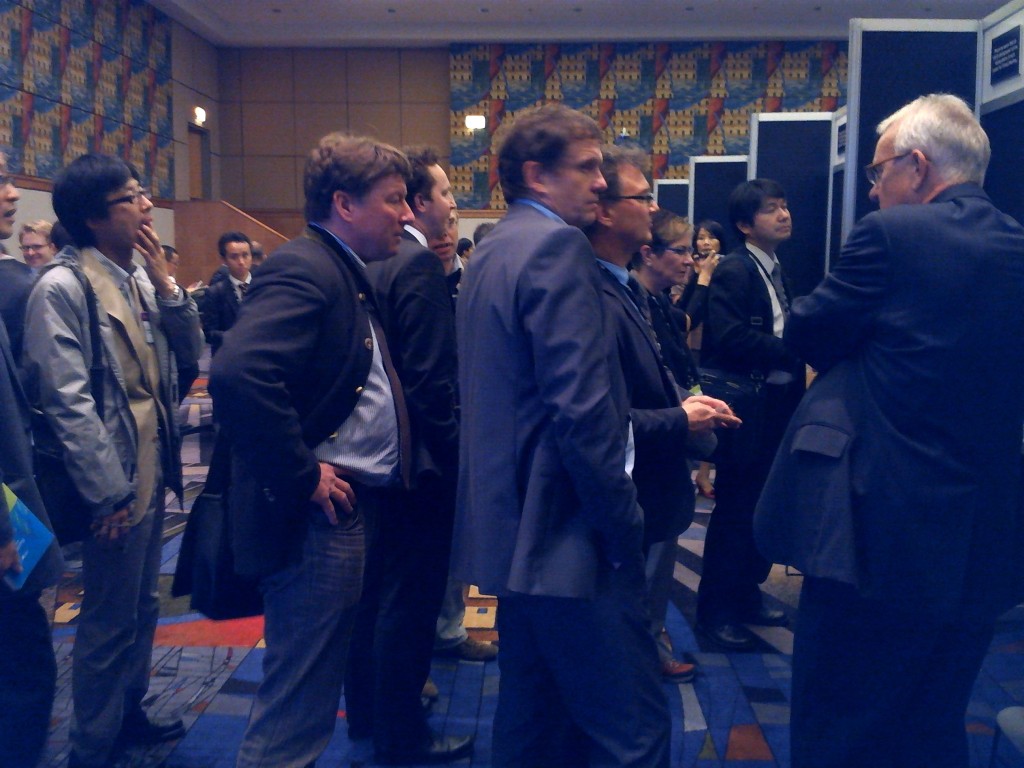ASCO 2013 : Nimotuzumab Abstracts

Professor Dirk Strumberg from Germany (center, in blue suit), the principal investigator of phase IIB/IIIA nimotuzumab clinical trial on pancreatic cancer, in discussion with Ferdinand Bach, CEO of Oncoscience AG, the sponsor of the trial, as the other ASCO participants viewed the Poster during the poster session.
1. Pancreas.
Phase II, randomized, double-blind placebo-controlled trial of nimotuzumab plus gemcitabine compared with gemcitabine alone in patients (pts) with advanced pancreatic cancer (PC).
Sub-category: Pancreatic Cancer
Category: Gastrointestinal (Noncolorectal) Cancer Meeting: 2013 ASCO Annual Meeting
Abstract No: 4009
Citation: J Clin Oncol 31, 2013 (suppl; abstr 4009)
Author(s): Dirk Strumberg, Beate Schultheis, Matthias Philip Ebert, A. Kerkhoff, Ralf Dieter Hofheinz, Dirk M. Behringer, Wolfgang E. Schmidt, Erdem Goker, Sara De Dosso, Michael Kneba, Suayib Yalcin, Friedrich Overkamp, Frank Schlegel, M. Dommach, Robert Rohrberg, Tilman Steinmetz, Dirk Reuter, Ferdinand Bach; Marienhospital Herne, Herne, Germany; University of Bochum, Marienhospital Herne, Herne, Germany; Medical Department II, University Hospital Mannheim, Mannheim, Germany; University Hospital Münster, Münster, Germany; Department of Hematology and Medical Oncology, University Medical Centre Mannheim, Mannheim, Germany; Augusta-Kranken-Anstalt, Bochum, Germany; University Hospital Bochum, St. Josef Hospital, Med. Klinik I, Bochum, Germany; Ege University Medical School, Izmir, Turkey; Oncology Institute of Southern Switzerland, Bellinzona, Switzerland; Department of Medicine, University Medical Center Schleswig-Holstein, Kiel, Germany; Hacettepe University Hospital, Ankara, Turkey; Medical Practice for Oncology and Hematology, Recklinghausen, Germany; St. Antonius Hospital, Eschweiler, Germany; Sana- Kliniken, Medizinisches Versorgungszentrum Onkologie, Dusseldorf, Germany; Gemeinschaftspraxis und Tagesklinik fuer Haematologie, Onkologie und Gastroenterologie, Halle, Germany; Group Practice Hematology/Oncology Cologne, Cologne, Germany; Oncoscience AG, Wedel, Germany
Abstract:
Background: FOLFIRINOX significantly increases survival in metastatic PC compared to gemcitabine, but its use is limited to selected pts, due its high toxicity. In the majority of cases, gemcitabine (gem) remains the mainstay of palliative treatment, although its modest impact on survival and disease progression. The addition of the EGFR tyrosine kinase inhibitor erlotinib prolonged median survival for only 2 weeks.This study was aimed to investigate the effect of adding Nimotuzumab (nimo), an anti-EGFR monoclonal antibody, to first-line gemcitabine, in PC. Methods: Pts with previously untreated, unresectable, locally- advanced or metastatic PC were randomly assigned to receive gem: 1000 mg/m2/ 30-min iv once weekly (d1, 8, 15; q28) and nimo: fixed dose of 400 mg once weekly as a 30-min infusion, or placebo, until progression or unacceptable toxicity. Primary endpoint was overall survival (OS) in the intention-to-treat (ITT) population. Secondary endpoints included PFS, safety, objective response rate (ORR), QoL.
Results: Between 9/2007- 10/2011 a total of 192 pts were randomized (average age 63.6 ±10 years; 60% male; 69% ECOG PS 0), and 186 were evaluable at the ITT analysis. One-year OS was 19.5 % with gem+placebo and 34.4% with gem+nimo (HR=0.69; p=0.034). Median OS and PFS were 6.0 mo in the gem+placebo group, vs. 8.7 mo in gem+nimo (HR=0.83; p=0.21), and 3.7 vs. 5.4 mo, respectively (HR=0.73; p=0.06). One-year PFS was 9.5 % for gem+placebo, compared with 21.5% for gem+nimo (HR=0.71; p=0.05). Significantly, in pts ≥ 62 years (60% of the population), median OS and PFS were 5.2 mo in the gem+placebo group vs. 8.8 mo in gem+nimo (HR=0.66; p=0.034), and 3.2 in gem+placebo vs. 5.5 mo in gem+nimo group, respectively (HR=0.55; p=0.0096).
Nimo was safe and well tolerated, and no grade 3/4 toxicities were observed. Thirteen % of pts experienced grade 1/2 skin toxicity. Conclusions: This randomized study clearly showed that nimo in combination with gem is safe and well tolerated. The 1-year survival rate is significantly improved. Especially pts ≥ 62 years seem to benefit, possibly due to a more aggressive biology in younger pts. Clinical trial information: NCT00561990.
2. NSCLC
Nimotuzumab plus chemotherapy versus chemotherapy alone in advanced non-small cell lung cancer: A phase II, open-label, multicenter, randomized study.
Sub-category: Metastatic Non-small Cell Lung Cancer Category: Lung Cancer – Non-small Cell Metastatic Meeting: 2013 ASCO Annual Meeting
Abstract No: 8053
Citation: Clin Oncol 31, 2013 (suppl; abstr 8053)
Author(s): Kumar Prabhash, Kanaka Govind Babu, Ashok K. Vaid, Ranga Rao Rangaraju, Bhawna Sirohi, Ravi Diwakar, Raghunadha Rao, Madhuchanda Kar, Hemant Malhotra, Shona Milon Nag, Chanchal Goswami, Vinod Raina, Pedapenki Ravi Mohan; Tata Memorial Hospital, Mumbai, India; Kidwai Memorial Institute of Oncology, Bangalore, India; Artemis Health Institute, New Delhi, India; Rajiv Gandhi Cancer Institute and Research Centre, New Delhi, India; Bangalore Institute of Oncology, Bangalore, India; Nizam’s Institute of Medical Sciences, Hyderabad, India; B.R. Singh Hospital, Kolkata, India; ICON-ARO, Medical Oncology, Jaipur, India; Jehangir Clinical Trials Development Centre, Pune, India; B.P. Poddar Hospital and Medical Research, Ltd., Kolkata, West Bengal, India; Dr. B.R. Ambedkar Institute Rotary Cancer Hospital, All India Institute of Medical Sciences, New Delhi, India; King George Hospital, Visakhapatnam, India
Abstract:
Background: To evaluate the safety and efficacy of nimotuzumab in combination with chemotherapy (docetaxel and carboplatin) versus chemotherapy alone in stage IIIB/IV non- small cell lung cancer (NSCLC) patients. Methods: This multicenter, open-label, phase II study, randomized 110 patients to receive nimotuzumab plus chemotherapy (nimotuzumab group) or chemotherapy alone (control group), and comprised concomitant, maintenance, and follow-up phases. Nimotuzumab (200 mg) was administered once weekly for 13 weeks during the first 2 phases with 4 cycles of chemotherapy; docetaxel (75 mg/m2) and carboplatin (area under the curve [AUC] = 5 mg/ml*min), every 3 weeks for a maximum of 4 cycles during the concomitant phase. The primary endpoint was objective response rate (ORR; sum of complete response [CR] and partial response [PR]). Secondary endpoints, overall survival (OS), and
progression-free survival (PFS) were estimated using Kaplan-Meier method. Efficacy was evaluated on the intent-to-treat (ITT) and efficacy-evaluable (EE) sets. Safety was assessed from adverse events (AEs) and serious adverse events (SAEs) data. Results: ORR was significantly higher in the nimotuzumab group than in the control group in the ITT (54% vs. 34.5%; P=0.04) population. CR and PR were achieved in 3.6% and 50% patients, respectively, in the nimotuzumab group, and in 4% and 30.9% patients, respectively, in the control group. No significant differences in median PFS and OS were observed. Safety profiles were comparable between the 2 groups. Conclusions: Nimotuzumab plus chemotherapy significantly improved ORR as compared to chemotherapy alone; the combination was safe and well tolerated in stage IIIB/IV NSCLC patients.
3. Esophagus
Nimotuzumab plus paclitaxel and cisplatin as first-line treatment for esophageal squamous cell cancer: A single center prospective clinical trial.
Sub-category: Esophageal or Gastric Cancer Category: Gastrointestinal (Noncolorectal) Cancer Meeting: 2013 ASCO Annual Meeting
Abstract No: 4097
Citation: J Clin Oncol 31, 2013 (suppl; abstr 4097)
Author(s): Xiaodong Zhang, Ming Lu, Xicheng Wang, Jie Li, Yan Li, Jian Li, Xiaotian Zhang, Jing Gao, Jun Zhou, Zhihao Lu, Jifang Gong, Jun Jia, Yan Cui, Jing Yu, Lin Shen; Department of Gastrointestinal Oncology, Peking University School of Oncology, Beijing Cancer Hospital and Institute, Beijing, China; Peking University Cancer Hospital and Institute, Beijing, China; Peking University Cancer Hospital, Beijing, China
Abstract:
Background: The aim of this present phase II study is to explore the safety and efficacy of paclitaxel (T), cisplatin (C), and nimotuzumab (N), a humanized anti-EGFR monoclonal antibody combination (TCN) as first-line treatment in advanced esophageal squamous cell cancer (ESCC). Methods: Patients with histologically confirmed advanced ESCC, measureable tumor, and no prior chemotherapy and radiotherapy except adjuvant treatment were enrolled. Patients were given cisplatin 60mg/m2, paclitaxel 175mg/m2per 21 days for at least 2 cycles. The nimotuzumab was given 200mg weekly. Radiotherapy was admitted for patients with unresectable local advanced disease after 4 cycle of TCN treatment. The primary endpoints were safety and objective response rate (ORR). The secondary endpoints were progression-free survival (PFS) and over-all survival (OS). The expression of EGFR and ERCC1 were also analyzed by histoimmunochemical staining.
Results: Between Mar. 2011 and Dec. 2012, 55 patients with advanced ESCC were enrolled and 53 (96.4%) were eligible for evaluation. The ORR was 54.7% (29/53) and the DCR was 94.3% (50/53). The expression of EGFR and ERCC1 were detected in 46 and 31 patients respectively. The ORR had no relation to both the expression of EGFR (55.3% vs 62.5%, p=0.71) and ERCC1 (41.7% vs 58.3%, p=0.47). As a median follow-up of 15months, the median PFS was 10.5 months (95% CI 8.7 to 12.3 months).The TCN combination treatment was well tolerated and the most common adverse events were alopecia (86.8%), leukopenia (84.9%), anorexia (84.9%), vomiting (73.6%), fatigue (73.6%), pain (66.0%), and anaemia (39.6%). And 18 (34%) patients had Grade 3 to 4 leukopenia. The median OS have not yet been reached. Conclusions: In this study, the ORR, DCR and PFS are superior to previous published studies. The addition of anti-EGFR treatment of nimotuzumab to standard chemotherapy was well tolerated with no serious AEs. But the expression of EGFR by IHC could not predict the outcome of nimotuzumab treatment. A phase III study of TCN followed by radiotherapy in unresectable local advanced ESCC had been designed to explore the survival benefits. Clinical trial information: NCT01336049.
4. SCCHN
Nimotuzumab with concurrent chemoradiotherapy in patients with locally advanced head and neck cancer (LASCCHN).
Sub-category: Head and Neck Cancer Category: Head and Neck Cancer Meeting: 2013 ASCO Annual Meeting Abstract No: 6084
Citation: J Clin Oncol 31, 2013 (suppl; abstr 6084)
Author(s): Naresh Somani, Karandikar SM, Kamlesh Bokil, Kumar Tapash Bhowmik, Shyam Agarwal; Bhagwan Mahaveer Cancer Hospital, Jaipur, India; Ruby Hall Clinic, Pune, India; Grant Medical Foundation Ruby Hall Clinic, Pune, India; Safdarjang Hospital; VMMC, New Delhi, India; Sir Ganga Ram Hospital, New Delhi, India
Abstract:
Background: Nimotuzumab is a humanized monoclonal antibody targeting EGFR receptors. Unlike other anti-EGFR monoclonal antibodies, it has demonstrated to be safe and effective when combined with chemotherapy or/and radiotherapy. We evaluated safety and efficacy of concurrently administrating nimotuzumab with chemo-radiotherapy in patients with locally advanced inoperable squamous cell carcinomas of head and neck region in a usual health care setting. Methods: Open-label single-arm study. Patients of age 18 years and above with histologically confirmed squamous cell cancer of head and neck region in an inoperable stage (stage III & IV) having an ECOG ≤ 2 were included in the study. Informed consent was obtained from all the patients. The patient were administered injection cisplatin (30 mg/m2 IV) and nimotuzumab (200 mg IV) weekly for six weeks along with radiotherapy of 6600cGy over 33 fractions. Patients were evaluated based on RECIST criteria 24 weeks after the last cycle of chemotherapy. Results: Fifty seven patients were enrolled in the study. Mean age of the patients was 51yr (29 yr-79 yr). Most common site of cancer was oral cavity 32 (56.14%). Fourty six (80.70%) patients completed 6 cycles of therapy. ORR was 80.7%, 34 with CR (59.6%), 12 with PR (21%), 8 with SD (14%), 3 with PD (5.2%). Most common adverse event seen was mucositis (33%) but there was no grade III or IV adverse event.
Conclusions: Addition of anti-EGFR monoclonal antibody (nimotuzumab) is safe and efficacious based on the loco-regional response and confirms the available phase II data. The long-term survival benefits based on this encouraging response rate needs to be further evaluated especially in patients with inoperable LASCCN.
Nimotuzumab plus chemotherapy versus chemotherapy alone in advanced non-small cell lung cancer: A phase II, open-label, multicenter, randomized study.
Category: [Lung Cancer – Non-small Cell Metastatic]
First Author: K. PrabhashAbstract No: 8053
>> View PDF 8053
Nimotuzumab with concurrent chemoradiotherapy in patients with locally advanced head and neck cancer (LASCCHN).
Category: [Head and Neck Cancer]
First Author: N. Somani
Abstract No: 6084
>> View PDF 6084
Nimotuzumab plus paclitaxel and cisplatin as first-line treatment for esophageal squamous cell cancer: A single center prospective clinical trial.
Category: [Gastrointestinal (Noncolorectal) Cancer]
First Author: X. Zhang
Abstract No: 4097
>> View PDF 4097
Phase II, randomized, double-blind placebo-controlled trial of nimotuzumab plus gemcitabine compared with gemcitabine alone in patients (pts) with advanced pancreatic cancer (PC).
Category: [Gastrointestinal (Noncolorectal) Cancer]
First Author: D. Strumberg
Abstract No: 4009
>> View PDF 4009
